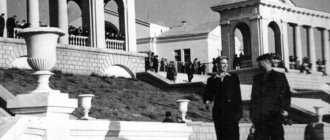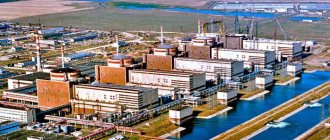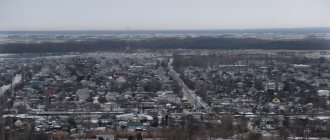The history of the city of Voronezh begins in the 16th century. By historical standards, the city is still a teenager, but has already seen a lot.
Voronezh witnessed the events of the Time of Troubles, the construction of the first Russian fleet and the battles of the Great Patriotic War. It was here that the TU-144 and IL-2 aircraft were designed and the production of the first domestic video recorders was launched.
Voronezh is the birthplace of the Oryol trotter and the place where mammoths once roamed. Here you can also find a monument to the kitten from Lizyukov Street from the cartoon of the same name and even take a swim in the “sea.”
Voronezh is very different: heroic, but a little provincial, strict, but at the same time sweet and cozy. Its wide green streets invite leisurely strolls. Photos of the city of Voronezh only partially convey its extraordinary atmosphere. This is not a metropolis with a frantic rhythm, but it is not a quiet provincial town either. Voronezh undoubtedly has a soul and a beating heart, which makes it so vibrant and attractive.
Let's take a deeper dive into the history of this amazing city and discover its innermost secrets, which it has silently kept for more than 400 years since its founding.
Cradle of Humankind
Did you know that mammoths once roamed the territory of modern Voronezh? And about 40 thousand years ago, primitive people came here and left numerous traces of their stay near the city.
Today from Voronezh you can take a train to the world-famous Kostenki Museum, located in the region. In the archaeological complex you can see with your own eyes the remains of the dwellings of ancient people and the bones of primitive animals.
Tens of thousands of years have passed since the last mammoth walked on Voronezh soil. Civilizations appeared and disappeared, cities were built and collapsed. And then, from the abyss of history, another city was born, located near the Don River.
XX century Revolutionary period
At the end of October 1905, there were mass riots in Voronezh. On October 21-22, 1905, the Black Hundred pogrom took place. In the same year, a mutiny arose in the Voronezh disciplinary battalion not far from the city, which was suppressed. In December 1905, a political strike took place in Voronezh. On December 16, 1905, Voronezh was declared under martial law. With the help of the Tambov authorities, the unrest was suppressed.
On October 30, 1917, Voronezh began to be governed by representatives of the Soviet government. In 1918, Yuryev University was transferred from Yuryev and Voronezh State University was created on its basis.
The photo shows the first Voronezh department store “Utyuzhok”.
In 1926, long-distance telephone communication was established in Voronezh, and tram service was opened. In 1930, the Chemical Technology Institute and the Forestry Institute were founded. On August 2, 1930, the first military landing in the USSR was carried out in Voronezh. From 1928 to 1934, Voronezh was the administrative center of the large Central Black Earth Region. At this time, a number of large industrial enterprises arose, the city “stepped over” to the left bank of the Voronezh River, and the development of the left bank began. In May 1926, the city opened a tram system. According to the population census conducted in December 1926, 120 thousand people lived in Voronezh.
Since June 13, 1934, Voronezh has been the administrative center of the Voronezh region (according to the resolution of the Presidium of the All-Russian Central Executive Committee, the Central Black Earth Region was divided into two regions: Voronezh and Kursk). In the pre-war years there was a rapid expansion of the urban area and improvement of Voronezh. According to the census in 1939, the city population was 362.8 thousand people, and the city took 19th place in the USSR in terms of the number of inhabitants.
First mentions
Although the remains of settlements dating back to the 8th-9th centuries are found on the territory of the modern city, the history of the city of Voronezh actually originates in the 12th century. We find the first message about the city in the Laurentian Chronicle for 1177. Nikonovskaya for the same period contains an even more detailed mention of the city:
Prince Yaropolk Rostislavich fled to Voronozh, and there he walked from city to city... And so he went to Voronozh, seized him, and led him to Volodymer
In total, Voronezh is described in ancient Russian chronicles no more than 3 times. Nevertheless, there is every reason to believe that the city of the same name was founded near the banks of the Don back in the days of Kievan Rus.
It is worth mentioning separately the name of the city of Voronezh, which could come from either the noun “raven” or the adjective “voronoi”. The water in the river could be black, that is, black, dark, on which the city of the same name was built.
And, finally, another version of the appearance of the name of the city is its origin from the ancient Slavic name Voroneg. Whether this mysterious man, after whom the ancient settlement was named, really existed, we will probably never know. Therefore, the name of the city will forever remain shrouded in an aura of mystery and mystery.
Cultural life of the city of Voronezh
(Voronezh Academic Drama Theater)
Voronezh is the center of cultural life of the Voronezh region. There are 7 theaters here (Voronezh State Academic Drama Theater named after A. Koltsov, Voronezh State Opera and Ballet Theater, Voronezh State Theater for Young Spectators, Voronezh Chamber Theater, Voronezh Puppet Theater "Jester", Theater of Equals, Creative), 11 museums (Voronezh Regional Museum of Local Lore, Voronezh Regional Literary Museum named after I. S. Nikitin, Voronezh Regional Art Museum named after I. N. Kramskoy, museum ship “Goto Predestination”, etc.), 4 large libraries, a circus, a philharmonic society, a network of cinemas.
(Monument to the Kitten from Lizyukova Street)
Every year, with the support of the Department of Education and Culture of the city of Voronezh, festivals such as the “Jazz Province” (since 2003), the All-Russian Festival of Japanese Animation (since 2000), the open poetry festival “Poetekh” (since 2007), and the international Platonov Festival ( since 2011).
There will be hail here
Despite the fact that the city is mentioned several times in ancient Russian chronicles, the official date of the founding of Voronezh is 1586.
The city existed on this site before, but it was in 1586 that the construction of the fortress, which was of great strategic importance, was completed. The construction of the fortification was initiated by Tsar Fyodor Ioannovich himself and was intended to protect Russian lands from attacks by the Crimean Tatars from the south.
The fortress and the city itself were almost completely destroyed during the Cherkasy raid in 1590, and four years later they were rebuilt. Thanks to its favorable location near the banks of the Don, the city acquired the status of an important trading hub and began to grow rapidly.
Since the Time of Troubles, difficult times have come to the city. The failure of the grain harvest led to widespread starvation and death. The streets of Voronezh are almost completely empty. The tithe duty imposed by Boris Godunov on the already impoverished residents also played a role. The city came out in defense of False Dmitry I, and after his death also provided all possible support to another impostor - False Dmitry II.
But hard times don't last forever. Gradually, discontent in the city subsided. Voronezh regained its strength and continued to exist as the most important outpost protecting the southern borders of the state.
The city of Voronezh is located in the Black Earth zone of Central Russia. This is one of the ancient Russian cities and the cradle of the Russian fleet. And in 2008, for the heroism shown by the city’s defenders during the occupation by German troops, which prevented them from completely capturing one of the main centers of the country, the city was awarded the honorary title of the Russian Federation “City of Military Glory.” Voronezh is located on the banks of the Voronezh reservoir of the Voronezh River, 8.5 kilometers from its confluence with the Don River, 587 km from Moscow. The administrative center of the Voronezh region, occupies an area of 600 square meters. km.
In total there were three Voronezhs in Rus'. The first city in terms of its origin was Chernigov, which arose in the 9th century. The second - Ryazan Voronezh is mentioned in chronicles in 1177; it was founded by Chernigov settlers. Subsequently, the name “Voronezh” ceased to be associated with the name, and the emphasis moved to the second syllable. And Voronezh began to be called the place, and then the river. And after the construction of the fortress in 1585, the new city was named after the river, Voronezh.
The founding date of Voronezh is considered to be 1586 - it was then that a fortress was founded to protect the southern borders of the Russian state, although people settled in these unusually fertile lands rich in fish and game a long time ago - archaeologists found Scythian burials of the 5th century, it is referred to as the town of Voronozh in the chronicles of the XII-XIII centuries.
Unofficially, Voronezh is called the capital of the Black Earth Region and the cradle of the Russian navy. It was here, under Peter the Great, that ships began to be built from local strong oak, which were rafted along the Don to the Sea of Azov. Over several centuries, the city has experienced many different events, which are reflected in the culture, architecture and monuments of the city. Like many cities of the late Russian Middle Ages, it grew out of a fortress, which was built on the southern borders of the Moscow state and was supposed to prevent and restrain the raids of the Nogais and Krymchaks in the Don steppes. From the Voronezh fortress at strictly defined times, horse detachments - villages - departed along their routes. The largest guard posts stood at the Rich Backwater. Voronezh was the first Russian military city on the southern border.
The official date of foundation of the guard fortress, called Voronezh, is considered to be 1586. It was on March 1, 1586 that boyar Nikita Romanovich Yuryev signed a Decree on the transformation of a guard town on the Don River into the city of Voronezh. The construction of the Voronezh fortress was led by the governor Semyon Fedorovich Saburov. The fortress burned several times, but each time it was restored very quickly. Peasant carpenters and service people from nearby places took part in the construction. Our ancestors were wise people who knew how to see the future, so the location of the new settlement was chosen very well. The point where the Voronezh River (at that time navigable) merged with the Don River turned out to be the most important point on the busy trade route, and the city began to grow very quickly. But some objective historical events did not allow the city of Voronezh to take a more significant place on the map and in the life of the Russian state.
During times of unrest, when state power was torn apart by boyars who, in order to achieve their goals, were ready to call on foreign kings to reign, the Voronezh residents, led by their boyars, swore allegiance first to False Dmitry I, and then to False Dmitry II. It was Voronezh that in 1610 became a refuge for False Dmitry II. But the townspeople did not swear allegiance to the Polish king, and the Cossacks of the rebellious ataman Zarutsky were defeated north of the city, and further Russian tsars from the Romanov dynasty up to Peter the Great did not favor Voronezh too much, depriving it of trade privileges.
During the Peasant War, which was led by Stepan Razin, Voronezh was distinguished by the fact that the uncle of the main rebel lived in the city, and the Voronezh governors had to make a lot of efforts to prevent a rebellion among the townspeople.
However, at the end of the 17th century, Peter the Great chose Voronezh as the cradle of the Russian Admiralty. It was here that the first warships of the future Russian fleet appeared. During the Great Patriotic War, the city was captured by the Nazis (not completely) and severely destroyed. After the war, the city was restored and rebuilt very quickly. Among the restored objects were not only factories and housing, but also museums and historical monuments.
The glory of St. Petersburg, which eclipsed the provincial city of Voronezh, overshadowed the significant fact that the history of the Russian fleet began with Voronezh. The first Russian ship was laid down here with the light hand of the reformer Tsar Peter the Great, and the city carefully preserves the memory of those events.
15 sights of Voronezh
Voronezh has interesting museums, numerous parks and picturesque squares. There are also monuments in Voronezh that are copies of Peter the Great’s first ships. There are many traditional Russian churches, theaters, and former merchant mansions in Voronezh that attract the eye with their noble and elegant appearance. There are also monuments perpetuating the image of the heroes of the Great Patriotic War. Of no less interest is the “Voronezh Sea” - a huge urban reservoir stretching for tens of kilometers.
The following 15 attractions are not all of the attractions of Voronezh.
1. Assumption Admiralty Church
The oldest church in the city that has survived to this day. It was erected in the 17th century (or at the end of the 16th century), after which it was repeatedly updated and rebuilt. The predominant architectural style of the building is classicism. In the 1930s, the temple was closed, and during the Second World War it was destroyed due to bombing. Since the 1970s, occasional restoration work has been carried out, but full reconstruction was carried out only in the 2000s.
2. Model of the ship "Mercury"
In Voronezh there is an unusual monument, which is located almost in the middle... of a reservoir! This is a monument to the ship "Mercury", launched in the times of Peter the Great. It can be seen from the bridge and from the shore. On a concrete pedestal rising out of the water, the ship "Mercury" rises - this is a model of the three-masted barcalon "Mercurius" - a 26-gun military sailing and rowing vessel built at a shipyard in the Voronezh province at the end of the 17th century. This ship had a glorious history. At one time, this frigate led a detachment of five ships on which the tsar carried out the Azov campaign. The model is a symbol of Voronezh - “the cradle of the Russian fleet”, because it is believed that one of the first shipyards in Russia was located in this city.
3. Admiralteyskaya Square
The square is located in the center of Voronezh within the Petrovskaya embankment. It was built in 1996 in honor of the 300th anniversary of the Russian fleet. The architectural dominant of the place is the high rostral column. The ensemble also includes the Assumption Admiralty Church of the 17th century. Admiralty Square often becomes the venue for concerts and mass celebrations of Voronezh residents and city guests.
4. Intercession Cathedral
The first wooden church on the site of the Intercession Cathedral was erected at the beginning of the 17th century; the stone church appeared many years later - at the end of the 18th century. In 1833-41 it was rebuilt in the classical style according to the design of the architect I. A. Blitsyn. During Soviet times, the building housed various institutions, including the local history museum, thanks to which the cathedral managed to survive.
5. Fountain “Floating Stone”
Undoubtedly, you can watch the fire burn and the water flow for an infinitely long time. This is probably why fountains are so popular in recreational areas - you can admire them, if not endlessly, then for a very long time. And if the fountain also has an original design, then it is doubly pleasant! There is just such an unusual fountain in Voronezh - three powerful jets of water soar up above a stone bowl, and above them is a huge boulder, it seems as if it is supported by a seething fountain. Of course, you can easily guess how the structure works, but the illusion looks impressive!
6. Petrovsky Square
A small park in the city center, named after the monument to Peter 1, first erected here in 1860. During the war, the monument was taken away by the German occupiers. In 1956, sculptors G. A. Shultz and N. P. Gavrilov created a copy of the stolen statue based on surviving photographs. Today Petrovsky Square is a popular place for dates and friendly meetings.
7. Historical monument Rotunda
The rotunda is an unusual monument to one of the bloodiest wars - the Second World Children's Hospital in Voronezh. There are only a dozen such buildings left in the world, destroyed during battles and preserved in the same form in which they appeared to the eyes of the victorious soldiers. Built in the 1930s, the hospital looked majestic, especially its grand entrance hall in the form of a rotunda with columns and a fountain, topped with a huge dome. But during the fighting that raged on the hospital grounds for more than two hundred days, the building was completely destroyed. And today its ruins are a striking monument to the events of the war. In 1942–43, during the battles for the city, this area passed from one warring side to another several times, as a result of which the structure suffered significant damage. After the end of hostilities, there was simply no money to restore the hospital; its brick walls were dismantled to build new residential buildings. In the end, only the concrete frame remained.
8. Voronezh Central Park
This is the main and largest park in the city, covering an area of about 100 hectares. Its history began with the creation of a plant nursery in 1844. After the establishment of Soviet power, the significantly expanded botanical garden was transferred to the management of the local university. During the Great Patriotic War, almost all green spaces were destroyed, so the park had to be restored almost from scratch.
9.Monument “Glory to Soviet Science” (DNA Molecule)
It is difficult to compete with the unusualness of the Voronezh monument “DNA Molecule” - no one else in the world has come up with the idea of creating such a monument. Although this monument glorifies Soviet science, this fact has long been forgotten. The history of its appearance is also unusual - initially it was in Zelenograd, as a symbol of the Institute of Radio Electronics, but for some reason it did not take root there, and it was exchanged for several tons of metal in Voronezh. But the residents of Voronezh immediately fell in love with Molecule, and when in 2010 they wanted to dismantle the monument, which was already in need of repair, the public stood up for it so ardently that the monument was not dismantled, but repaired.
10. Museum ship “Goto-Predestination”
The museum ship “Goto-Predestination” is a copy of a real ship from the times of Peter the Great, standing near Admiralty Square. The idea of creating a museum ship came to the minds of the Voronezh authorities in 2009. At first it was assumed that specialists from Denmark would work on it, but in the end the structure was built by Russian craftsmen. The museum was inaugurated in 2014 on Navy Day. Its exhibition consists of items telling about the origin and development of the navy. On this ship you can not only take pictures, but even visit its board, wander through the cabins and holds. After all, an exact copy of the first Russian linear ship, Goto-Predestination, launched in 1700, is moored at the Admiralty Embankment. The ship is a delightful sight - elegant masts with folded sails, yards, rope ladders, skillfully made latrine figures on the bow, ancient cannons... Looking at it, you seem to go back several centuries - it seems that sailors are about to appear on board and the captain himself in ancient costumes.
11. Voronezh Reservoir
This is one of the world's largest artificial reservoirs located within the city. Its length is about 30 km. The reservoir was created in 1971–72 along with a dam in order to provide Voronezh with water. On its territory there are several uninhabited islands - former hills. Local residents often call the reservoir the “Voronezh Sea” because of its incredible size.
12. Koltsovsky Square
Koltsovsky Park is one of the popular recreation areas for city residents. There is a light and music fountain and a bust of A.V. Koltsov, created by the sculptor A. Triskorni. The square appeared in 1871; at the beginning of the 20th century it became a favorite place for a summer evening promenade. In 2009, after reconstruction, the park was transformed: new lighting was installed and paving slabs were replaced.
13. South Eastern Railway management building
This building is considered one of the most beautiful in Voronezh; it is a symbol of the pre-war era with its inherent gigantomania, the desire for labor feats and a colossal leap in industry. This is an administrative building built in 1929–32, built in the style of Soviet constructivism. It was damaged during the war, after which it was restored in a pseudo-classical manner.
14. Victory Square
One of the central squares of Voronezh, on which there is a memorial complex in honor of the defenders of the city. Its opening took place in 1975 on the 30th anniversary of the Victory. The monumental monument made of red granite and metal is located in the northern part of the city. It consists of 12 figures depicting all branches of the Soviet Army, as well as partisans and militias. The Eternal Flame burns in front of the silently frozen statues.
15. Voronezh Oceanarium
This is the very first aquarium, opened in the Central Federal District in 2011. Its pools and aquariums are home to about 200 species of fish, several dozen marine mammals, as well as reptiles and birds. The oceanarium is divided into four zones, each of which introduces visitors to the fauna of a specific natural zone of the Earth. In total, about 4,000 animals live in the Voronezh aquarium. Some representatives of the oceanic fauna can only be seen here. For example, electric eels, Japanese moray eels and spider crabs, sand tiger shark.
25 interesting facts about Voronezh
1. First of all, Voronezh went down in Russian history as the birthplace of its country’s navy.
2. For the first Russian regular Navy in 1696-1711, 215 ships were built at the Voronezh Admiralty.
3. It was these ships that took part in the conquest of the Azov fortress.
4. From the Voronezh region to the Greenwich meridian - 2710 km, and to the Equator - 5772 km
5. While in Voronezh, Peter the Great made a model of the fortress. Subsequently, this fortress received the name Kronstadt.
6.26 June 1941 in Voronezh at the Comintern plant the assembly of the first two serial BM-13 launchers on the ZIS-6 chassis was completed, which later received the popular name “Katyusha”.
7. The Comintern plant in Voronezh became a district-forming plant - one of the six city districts - Kominternovsky - is named after it.
8. In Voronezh, for the first time in the world, the Tu-144 aircraft was built serially at the Voronezh Aviation Plant in 1968.
9. In Voronezh in 1942, the urban design trust invented the repair of burnt-out light bulbs, and the workshops of the city industrial plant mastered this repair.
10.The first domestic video recorders began to be produced in 1980 in Voronezh.
11. The group "Gaza Strip" - originally from Voronezh. Two songs are entirely dedicated to this city - “Local” and “Gaza Strip”.
12. The fan group of the Fakel football team in the mid-to-late 1990s, along with Zenit, Spartak and CSKA, was considered one of the most significant in Russia.
13. In Voronezh, for the first time in the world, “giants of the sky” were constructed - the Il-86 and Tu-144 aircraft.
14. In Voronezh, the galley “Principium” was assembled in parts brought from the village of Preobrazhenskoye.
15. On the galley “Principium” on the way to Azov, Peter the Great signed the “Charter on Galleys,” which can be considered the first naval charter of Russia.
16. At the beginning of the 19th century, Voronezh was already the center of the province and formed militia regiments to fight the French. These regiments performed excellently during the Crimean War.
17. From Voronezh to Moscow, Tsar Peter the Great sent a letter to clerk Andrei Vinius. This letter was with the personal monogram of the sovereign.
18. Annunciation Cathedral in Voronezh is the third largest in Russia.
19. And now this monogram is depicted on the modern Coat of Arms and Flag of the city of Voronezh.
20. The names of poets A. Koltsov and I. Nikitin, writers I. Bunin and A. Platonov are associated with Voronezh.
21. S. Marshak was born in Voronezh.
22. V. Zhukovsky, L. Tolstoy, A. Chekhov, G. Uspensky visited Voronezh.
23. In 1700, the first Russian battleship and the first ship of rank IV according to the European classification of the early 17th century, created in Russia without the participation of foreign specialists, were launched at the Voronezh shipyard.
24.This ship was named Goto Predestination (Latin: God's Predestination);
25. In Voronezh, the Assumption Church, made in the ancient Russian style, has survived to this day. Ships were consecrated here. The sovereign himself not only took part in the consecration of the ships, but also sang in the choir in the temple.
photo from the Internet
The birth of the Russian fleet
The city received a completely new round of development with the decision of Peter I to organize the construction of the first Russian naval fleet in Voronezh.
The city was not chosen for this purpose by chance. The strategically convenient location next to the Don, relative proximity to the Sea of Azov and dense forests around became the determining factors in the king’s decision.
Peter I was a man of action, so already in 1769 the first ship, the galley Principium, left the Voronezh shipyard, which subsequently took part in the victorious capture of the Azov fortress.
But this was only the first sign. A total of 215 warships were built in Voronezh. The powerful fleet became the real pride of the Russian Empire.
Administrative center
The city continued to grow and soon took its place as an important administrative unit in the south of the Russian Empire. A cadet corps, a hospital, a theater opened in Voronezh, and pharmacies and shops began to appear.
By the beginning of the 20th century, the city's population reached 60,000 people. New jobs were created, the first educational institution was opened - the Peter the Great Agricultural Institute.
But a terrible test lay ahead - the Great Patriotic War, which forever changed the face of not only Voronezh, but the entire country as a whole.
Everything for the front, everything for victory
The city of military glory, Voronezh, played a vital role in the defense against the Nazis.
For 212 days, the right bank part was occupied by German troops. More than 90% of buildings were destroyed and thousands of civilians were killed. But the city did not give up and was liberated by the heroic efforts of the Soviet army.
From the very beginning of the war, Voronezh enterprises began producing weapons and special-purpose equipment. It was here that the BM-13 launchers, known throughout the world under the name “Katyusha”, were created.
A walk through modern Voronezh
Voronezh today is a large city with a population of more than 1 million people.
Tourists from all over Russia often come here. There really is a lot to see in Voronezh: the beautiful nature of the Don region, the reservoir, also called the “Voronezh Sea” for its impressive size, archaeological monuments and, of course, the city itself with its cozy streets, green parks and neat embankment.
Look at the photo of the city of Voronezh and feel its calm, slightly relaxed atmosphere. Better yet, come here in summer or spring. Walk along the streets steeped in history, stop at the embankment and enjoy the views of the river. Take your time, breathe deeply and absorb the atmosphere of the glorious city, which is always open to everyone who wants to take a closer look at its friendly face.
Industry of Voronezh
()
After the collapse of the USSR, the city, whose leading industries were mechanical engineering, metalworking, electronic and chemical industries, experienced some economic difficulties, many plants, factories and combines were on the verge of bankruptcy. Now the Voronezh region ranks 38th in Russia in terms of industrial output volumes; the city's economy is experiencing a state of stagnation (i.e. stagnation).
(Voronezh Aircraft Plant)
Among the large enterprises of the mechanical engineering and metalworking industry in Voronezh one can highlight the Voronezh Joint-Stock Aircraft Manufacturing Company, Voronezhstalmost, Rudgormash, Tyazhmekhpress (here in 2010 they first created a powerful crank hot stamping press), Voronezh Car Repair Plant, Voronezh Diesel Locomotive Repair Plant, Voronezh Mechanical , "Voronezh Aluminum Plant". Chemical industry - Voronezhsintezkauchuk, Voronezh Tire Plant, Voronezh Ceramic Plant, Voronezh Glass Container Plant.
(Monument to the famous Druzhba cheese cheese to this day)
Food industry - Voronezhsky Dairy Plant, Voronezh Yantar Processed Cheese Factory, Voronezh Confectionery Factory, Voronezhsky Meat Plant. Electronics industry – concern “Sozvezdie” and its subsidiaries.
Also in Voronezh the service sector and wholesale and retail trade are very well developed.











